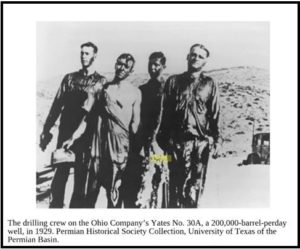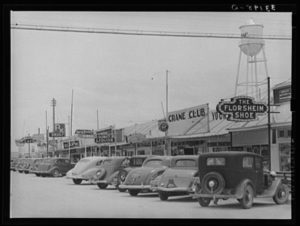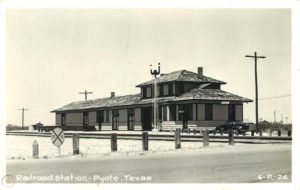Population growth created by the first ten years of oil production in the Permian Basin was remarkable. Once the Big Lake field began to develop, a veritable deluge of oil men poured into the Permian Basin. As it turned out, during the mid to late 1920s, that vast lightly inhabited region with no known oil prospects blossomed into the hot spot of the state’s oil and gas development. What had been a grim and foreboding landscape sprinkled with only a handful of hardy residents became a dynamic bustling region dotted with a number of new towns that seemingly sprang up overnight to accommodate the surge of newcomers. It had all the ear markings of the raw frontier environment that had characterized western settlement of the previous century.
 The first major find following the Big Lake field was right down the railroad tracks about 50 miles to the west. It all began early in September of 1925 when wildcatters George B. McCamey and J.P. Johnson of Fort Worth brought in a well in southwestern Upton County about 50 miles west of the Santa Rita #1. In order to service his drilling operation, McCamey parked some boxcars on a siding near the drill site to act as a supply warehouse. Immediately after the well came in, town promoters surveyed a town site adjacent to the siding. They appropriated the verbiage from the hand scrawled sign on the side of the cars for a name and thus the town of McCamey was born. By early1926 seven major oil companies had leased up most of the acreage in the area and on March 5, 1926, the town was incorporated with a population estimated at 10,000.
The first major find following the Big Lake field was right down the railroad tracks about 50 miles to the west. It all began early in September of 1925 when wildcatters George B. McCamey and J.P. Johnson of Fort Worth brought in a well in southwestern Upton County about 50 miles west of the Santa Rita #1. In order to service his drilling operation, McCamey parked some boxcars on a siding near the drill site to act as a supply warehouse. Immediately after the well came in, town promoters surveyed a town site adjacent to the siding. They appropriated the verbiage from the hand scrawled sign on the side of the cars for a name and thus the town of McCamey was born. By early1926 seven major oil companies had leased up most of the acreage in the area and on March 5, 1926, the town was incorporated with a population estimated at 10,000.
McCamey housing followed the pattern of previous oil boom towns—a pattern of slapping together small shotgun houses along with tarpapered shacks with corrugated metal roofing augmented by the occasional side-walled tent. But the settlement quickly matured into a real town complete with a bustling Main Street replete with all the amenities, such as grocery and dry goods stores along with barber shops and the like. Nevertheless, residential housing dominated by the ubiquitous shotgun housing and dormitory-type cot houses were more the norm as several lulls and small booms waxed and waned in the general area up until the beginning of the 1930s.
In March of 1926 some 20 miles north, just as McCamey was officially incorporated, Crane County, boasting a population numbering 37 lonely souls, saw its first oil well drilled. It didn’t take long for a boom to develop. By mid-1926 the town of Crane was a reality, with an estimated population of 4,000 serving an even larger community living in the oil camps being built across the county by major oil companies. If anything, the town of Crane, without the advantage of being near a railroad and surrounded by a region of sand hills that made road access exceptionally difficult, was even more isolated than McCamey.
Meanwhile, another boom was in the making some 20 miles southeast of McCamey in far eastern Pecos County. It had its genesis back in 1923 when a struggling rancher, Ira Yates, began trying to persuade oil companies to lease part of his more than 20,000 acre ranch in order to stave off financial ruin. He finally persuaded the Big Lake Oil Company to lease 8,000 acres and after drilling a couple of dry holes the discovery well for the Yates oil field came in on October 28, 1926. Legend has it that after that Yates did business on the front porch of his ranch house where on one memorable day he signed $180,000 worth of leases.
Immediately after the Yates boom began, the short-lived boom town of Red Barn developed just across the Pecos River from the ranch headquarters. It was so wild and woolly that another site arose, a few miles upriver adjacent to a newly built oilfield camp. It was christened Iraan, a combination of the names of Ira Yates and his wife Ann, when it was established early in 1927. Iraan remained a stable and long lived community that still exists today. The Yates field was one of the most prolific discoveries in the first days of oil activity in the Permian Basin. It is noteworthy that all the wells in the field were less than 2,000 feet in depth and were drilled almost entirely with portable cable tool drilling machines in contrast to the big standard wooden cable tool drilling rigs in common usage across the region.
By 1927 the southern portion of the Permian Basin was well established as a major oil and gas producing region. In only four years the flurry of activity that began with the completion of the Santa Rita #1 in 1923 had brought to light several major new oil fields and attracted thousands of new citizens to the region. Additionally, the unique company town of Texon was established as well as McCamey, Crane, and Iraan, while a host of short lived communities like Santa Rita and Red Barn were born and died along with a host of others who never got beyond the idea stage.
 As intense oil and gas activity continued in the southern Permian Basin while other finds came to light further north. The first of those was the Hendrick #1well completed by Roy Westbrook on July 16, 1926, in the sandhills of Winkler County, population 81, about 20 miles north of the Texas Pacific Railway. However, because of its isolated location and lack of pipeline connections it was not until early 1927 that serious development began. By mid-1927 the Wink town site company began selling lots amidst the sandhills of the Hendrick field and within a year more than 200 rigs were running in the immediate area. Wink quickly outstripped several other townsite company locations in the area and soon became the focus of the developing boom.
As intense oil and gas activity continued in the southern Permian Basin while other finds came to light further north. The first of those was the Hendrick #1well completed by Roy Westbrook on July 16, 1926, in the sandhills of Winkler County, population 81, about 20 miles north of the Texas Pacific Railway. However, because of its isolated location and lack of pipeline connections it was not until early 1927 that serious development began. By mid-1927 the Wink town site company began selling lots amidst the sandhills of the Hendrick field and within a year more than 200 rigs were running in the immediate area. Wink quickly outstripped several other townsite company locations in the area and soon became the focus of the developing boom.
The closest railroad connection to the new field was tiny Pyote on the Texas and Pacific Railway 20 miles to the south. Overnight Pyote gained an estimated population of 20,000 transient oilfield workers who rushed to the area. That unprecedented growth lasted only a couple of years before the railroad built a spur line from Monahans to the site of the drilling activity and little Pyote lapsed back into a well earned obscurity. Meanwhile, Wink developed the dubious reputation of the wildest of the West Texas boomtowns due primarily because its establishment coincided with martial law being declared in Borger up in the panhandle due to the unbridled lawlessness operating there. The well organized criminal element from Borger simply transferred their activities to Wink and carried on business with little interruption. Estimates on the size of Wink vary wildly during the height of the boom, but by 1930 its official population was listed at 6,000 although the Hendrick field was in somewhat of a production decline due to salt water encroachment into its wells combined with a significant drop in the price of oil.
Oil discoveries on the western edge of the Permian Basin continued northward into Eddy and Lea Counties of New Mexico. Minor oil discoveries began as early as 1923 near Artesia in Eddy County, which resulted a slow general growth in activity that continued until the disastrous decline in oil prices around 1930. That area was not destined to gain great momentum until the mid-1930s. Meanwhile, to the north in Lea County near the tiny town of Jal on November 1, 1927, the Texas Company brought in the Rhodes #1 as a good oil producer and on June 22, 1928, they completed another that served up more than 90 million cubic feet of gas. The boom was on for a while until the results of the slowdown at the beginning of the 1930s put a damper on things.
Activity continued to develop in Lea County. In 1928 the first producing oil well was drilled in the vicinity of Eunice, which expanded its population from a few hundred to 5,500 by 1930. In addition to that growing activity the Midwest Oil Company drilled the first producer near Hobbs in 1927. The following year a refinery was built in the vicinity and in 1929 Hobbs became large enough to be incorporated. At its peak during that boom the town had an estimated population of 12,000, but by 1930 its official population was 3,000 although it was destined to become the center of oil and gas activity in Lea County, which itself in coming years would become the largest petroleum producing county in New Mexico.
So it was that between 1920, when the first known oil producing well in the Permian Basin was drilled on its eastern edge near Westbrook in Mitchell County, and 1930, when oil was being produced in eastern New Mexico on the western edge of the Basin, the outlines of the greatest oil producing region in the United States were drawn. Oil production reached phenomenal numbers during that time frame, but a little noticed factor associated with the opening of such a large petroleum producing region was that the activity brought a significant population to one of the most sparsely settled regions of Texas.
Gaining an accurate accounting of that population explosion is difficult to ascertain given the chaotic nature of oil booms. When things were at their height with drilling going full blast, large pipelines being built, tank farms under construction, and all the associated supply personnel needed to keep things running, there was a tremendous amount of temporary labor in the area. As the boom phase faded and things settled into a more normal operating mode, the permanent population gradually came to light. For example, McCamey at the height of the boom in 1926 was estimated at 10,000, Pyote at 20,000 during the opening of the Hendrick field, and Hobbs at 12,000 during the height of its boom. However, the 1930 census shows both McCamey and Hobbs in the 3,000 range and Pyote with only a couple of hundred.
The official U.S. Census indicates that when oil was discovered in the Permian Basin in 1920, the 20 core counties of the Basin had a settled population of 44,656, a figure that would expand almost threefold in just ten years, to 120,408. That growth was particularly significant in the southern part of the area south of the Texas and Pacific Railway (present day I-20), where the original discoveries lay. That region’s 6,297 citizens in 1920 grew to 21,112 by 1930. North of that line there were 38,359 residents in 1920, which increased to almost 100,000 by 1930. But given the large size of the region, all that population growth still left the Basin a lightly populated area.
At the beginning of the 1930s most of the southern part of the Permian Basin had begun to settle into steady oil production while the discovery trend was definitely on the move to the north. At that point there was a significant slowdown in discoveries in the Permian Basin, caused by several factors. One of those was the onset of the Great Depression that curtailed all economic expansion across the nation. The other was the 1930 discovery of a massive oilfield in East Texas that drew large numbers of workers away from the Basin. That East Texas discovery was also characterized by unbridled oil production that caused the price of crude to drop as low as ten cents a barrel at one point. It took most of the decade of the 1930s for the Basin to gradually bring itself back to a situation of increasing financial prosperity and a growing population.
____________________________________________________________________________________________________
By Bobby Weaver










Very interesting but you failed to mention metropolitan Porterfield.